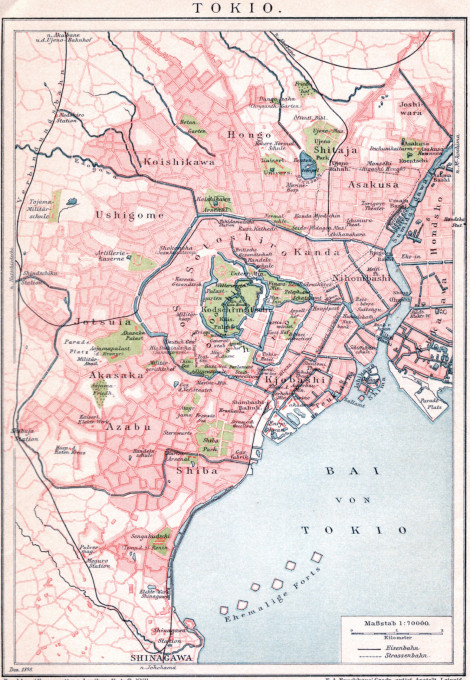
Drying of Laver at Shinagawa, c. 1910. During the Edo period, Shinagawa was a rural post station outside the Edo city limits. Off-shore nori (seaweed) aqua-culture was established by the first Shogun, Ieyasu, when it was discovered lush bushes of algae could be cultivated on wooden piles driven into the bay. Seaweed production around Shinagawa was permanently ended by the 1960s with the opening of the Hamamatsu-Haneda monorail.
“Nori doesn’t grow naturally in flat sheets. Instead, it collects in little dark green Vandyke beards on rocks or other objects ranging in depth from the tide-line to 25 feet below the surface on the oceans all around Japan.
“Collecting it from the sea was difficult and even a little dangerous until the 17th century Tokugawa era, when the Shogun Ieyasu Tokugawa decided he wanted fresh fish served to him on a daily basis. He assigned the fishermen of Shinagawa, a town at the mouth of the Sumida River on the southeast edge of what is now Tokyo, the task of providing the fish.
“The fisher men built weirs to keep a steady supply of fish at hand. Before long, they noticed the wooden struts of the weirs were sporting lush bushes of algae, tasty algae of the sort that had previously been harvested only in the wild. Thus was born the nori aqua-culture, which made the tasty treat more affordable.”
– The Connoisseur’s Guide to Sushi: Everything You Need to Know About Sushi Varieties and Accompaniments, by Dave Lowry, 2010
“Approaching Shinagawa, we see the forts built in Tokyo Bay during the latter days of the Shogunate, to impede hostile access to the great city, but now dismantled because useless in modern warfare. Owing to the rapid silting up of the bay and of the mouth of the river Sumida, only vessels of light burthen [burden] can proceed beyond this point.
“Extensive reclamations of land from the sea have been made here of late years. The numerous factory chimneys seen on nearing Tōkyō are innovation of the last fifteen years. Many, it will be noticed, are of thin iron tubing instead of the usual brick.
“This plan is adopted as a safeguard against earthquakes, which natural visitation affects the Tōkyō-Yokohama district with special frequency owing to the fact that (as demonstrated by Prof. John Milne) two lines of seismic activity here intersect.
“Just beyond some gas-works, the line skirts past the prettily laid out garden of the Shiba Rikyū, one of the minor Imperial palaces. A little further on, the noble trees in the grounds of the summer palace called Hama Rikyū are seen; and soon after, the train enters the Shimbashi terminus, and the traveller is in Tokyo.”
– A Handbook for Travellers in Japan, by Basil Hall Chamberlain & W.B. Mason, 1913

Portrayal of Shinagawa Edo era vs. Meiji era (inset), c. 1920, depicting the seaweed industry for which the area was famous. The postcard is captioned: “Asakusa seaweed is produced in Omori, Shinagawa and other areas, and is called Asakusa seaweed because it was produced in those areas in the past but is now called Asakusa seaweed.”




Pingback: Tokyo Monorail, c. 1970. | Old Tokyo
Pingback: Tokaido, Shinagawa, Tokyo, woodblock reprint c. 1920. | Old Tokyo
Pingback: Shell gathering at low tide, 1905. | Old Tokyo
Pingback: Aerial view of Shinagawa Station and nearby hotels, c. 1980. | Old Tokyo
Pingback: A View of Shinagawa Bay, c. 1910. | Old TokyoOld Tokyo